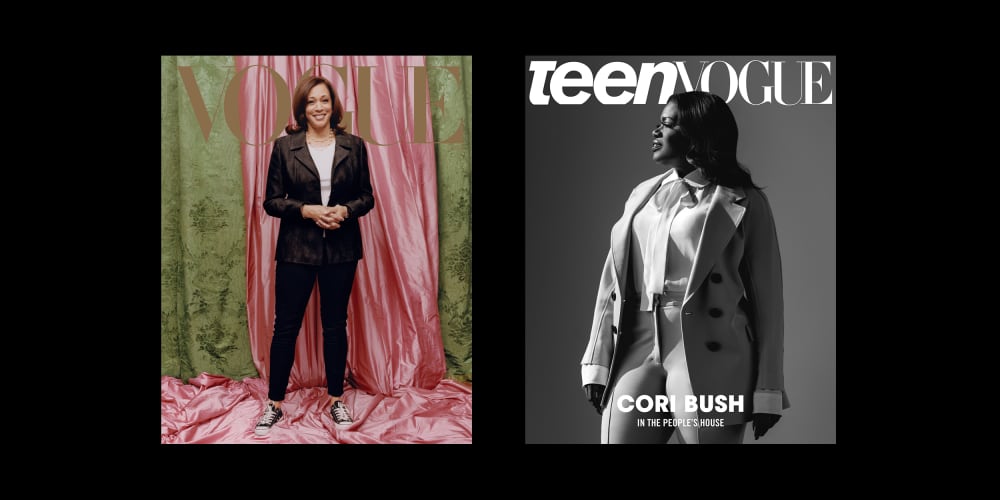On Wednesday, the nation watches the inauguration of the first woman, first Black person and first South Asian person elected to the position of vice president.
The day before, Teen Vogue kicked off the new year with an inspired January cover featuring U.S. Rep. Cori Bush, the registered nurse and Ferguson activist who recently became the first Black woman elected to represent Missouri in Congress. One week earlier, the magazine’s big sister publication Vogue had revealed its latest print cover, which spotlights Vice President Kamala Harris — but there’s a striking difference.
Both images feature a Black woman who has successfully scaled seemingly insurmountable barriers to become a “first.” But only one reflects the magnitude of this moment.
Centered against a simple, seamless backdrop, poised and picturesque, Bush commands the striking black-and-white Teen Vogue cover, while the Vogue cover seems more like a test shot of Harris taken to check lighting levels and depth of field before the actual photoshoot begins. Both images feature a Black woman politician who has successfully scaled seemingly insurmountable barriers to become a “first.” But only one reflects the magnitude of this moment in American politics, American media and American history.
Tell me why Teen Vogue’s Cori Bush makes Vogue’s Kamala Harris cover look 10x worse? Maybe the @voguemagazine editors need to do an internship at @TeenVogue? https://t.co/JM0Cgi0dPw
— Stacey Abrams Stan (@DeeLovelyone79) January 19, 2021
Across social media and within fashion media circles, much has been said about exactly how Vogue fumbled the Harris cover and why this even matters in the grand scheme of things like violent riots that overtook the Capitol — particularly to Black women.
“The selected photo is determinedly unfancy. Kind of messy. The lighting is unflattering. The effect is pretty un-Vogue,” New York Times fashion director and chief fashion critic Vanessa Friedman wrote in a recent article.

Washington Post senior critic-at-large and former Vogue editor Robin Givhan broke down the disrespect of it all: “Nothing about the cover said, ‘Wow.’ And sometimes, that’s all Black women want, an admiring and celebratory ‘wow’ over what they have accomplished.”
The Bush cover, on the other hand, had major “wow” factor, judging from the overwhelmingly positive responses on social media, and I’d have to agree.
Teen Vogue needs to give Grown Vogue lessons on how to select the cover shot of a Black woman in power. 💅🏽 https://t.co/lR4YwaFgtj
— Midwin Charles, Esq. (@MidwinCharles) January 19, 2021
So, how did Teen Vogue magazine get its cover so right, while Vogue’s failed on every level? The Black creatives behind the Harris cover aren’t to blame. Photographer Tyler Mitchell has proven his talents and range with previous cover photographs, like his image of Alexandria Ocasio-Cortez for Vanity Fair and his 2018 September issue image of Beyoncé, which made him the first Black photographer to shoot a Vogue cover.

Mitchell also photographed the better-received digital cover of Harris, which the magazine ultimately made available for sale as a special inauguration print issue this week. As for the sitting editor Gabriella Karefa-Johnson, sis has a sterling track record of creating innovative covers for a wide range of celebrities, with an obvious passion for portraying pioneering Black artists in an inventive, ever-changing light. That leaves the decisionmakers, the editor-in-chief and top editors and directors who ultimately decide on the cover. This tale of two covers proves why diversity, equity, and inclusion matters in the workplace, especially among top leadership.












